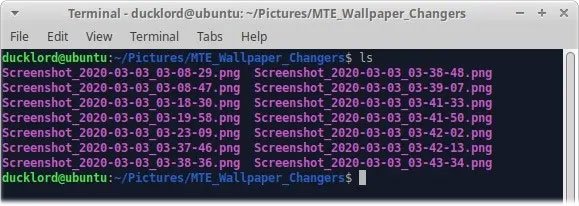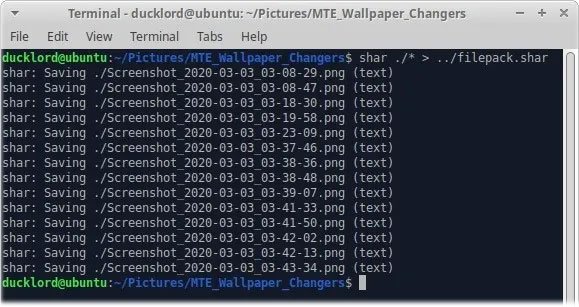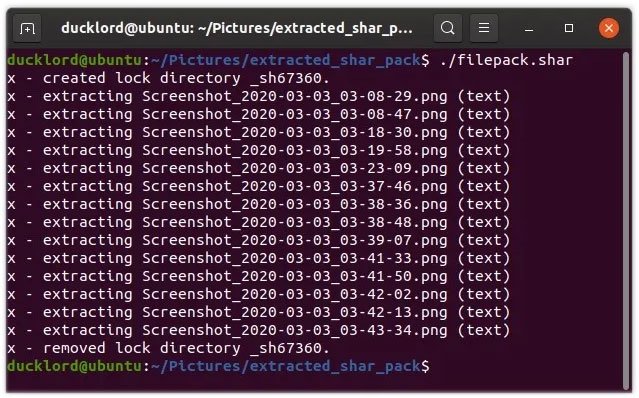How to create self-extracting archives with shar in Linux
It's annoying, even tiring, to explain to someone how to unzip after you send them an archive. If so then you will definitely love shar in Linux.
With shar, you can 'bundle' multiple files together. If you send it to someone, they just need to make sure it is executable and run to extract it. No need for complex commands or instructions during the process.
Let's see how you can use shar to group files through the following article!
Install shar
Shar is not included in most Linux distributions by default, so you will have to install it first in order to create Shar file archives automatically extracted. However, you won't find it in Software Center or via apt. Instead, you will have to install larger sharutils packages that contain shar. To do that, activate Terminal and use the command:
sudo apt install sharutils Shar is a command line tool and works on multiple files at once, putting them into a single archive. Therefore, for convenience and ease of use, create a temporary directory and move or copy all the files you want to put into the shar archive to that temporary directory.
With the Terminal still active, use the cd command to move the file into the newly created directory.
 Use the cd command to move the file into the newly created directory
Use the cd command to move the file into the newly created directory Group files
To create a shar archive, run the following command:
shar ./* > ./archive-filename.shar Change archive-filename to the preferred file name.
Feel free to dig deeper to understand how you can use your files.
- Of course, shar is the program.
- ./* is the input, and in this particular case, it means all the files in the directory.
- > separates the input and the output of the command. The program understands it as follows: Take all the input on the left of the> and combine it into a single file identified on the right of the>.
- ./archive-filename.shar is the path and name of the output file. You can change it to whatever you want.
This process is quite fast and usually does not take more than a few seconds (depending on PC performance).
 Group files
Group files Once you've created the archive, you can share your new files with others. Although they will also need sharutils installed to automatically extract operations, as you will see in the next step, things will be simpler than dealing with regular repositories.
Extract shar archive
When the other person receives the shar repository, all they need to do is make it workable, then run it.
Assuming the other person has sharutils installed, they can extract the archive using the following commands:
chmod +x archive.shar ./archive.shar The files contained therein are extracted right next to, in the same directory.
 Extract shar archive
Extract shar archiveYou should read it
- How to enable / disable the Archive Apps feature in Windows 10
- 4 ways to fix the error extracting ZIP files 0x80010135 in Windows 11/10
- How to Archive Folders
- How to Unrar Files in Linux
- How to review old data on a Web site using Archive.org (Wayback Machine)
- How to Archive in Outlook 2007
- How to Protect a Zip File with a Password on PC or Mac
- Archive Extractor - Free online decompression tool with over 70 different file formats
May be interested
- Repair, decompress, restore data in corrupted rar archives, errors in 3 ways - 99% success
 instructions on how to fix corrupted .rar archives: repair rar archives with the built-in tool in winrar; by the option keep broken files or by recovery toolbox for rar software
instructions on how to fix corrupted .rar archives: repair rar archives with the built-in tool in winrar; by the option keep broken files or by recovery toolbox for rar software - How to automatically delete Zip files after extracting on Mac
 there are many ways to reduce clutter and keep your mac neat. you can use powerful software like clean my mac, or take advantage of apple's existing features to keep your hard drive neat.
there are many ways to reduce clutter and keep your mac neat. you can use powerful software like clean my mac, or take advantage of apple's existing features to keep your hard drive neat. - How to create a Live CD Linux disc
 a live cd is a bootable cd, dvd or usb drive with an operating system ready to run when the disc is inserted into the computer. this article will show you how to create a linux live cd.
a live cd is a bootable cd, dvd or usb drive with an operating system ready to run when the disc is inserted into the computer. this article will show you how to create a linux live cd. - Create your own Linux distribution with Ubuntu Imager
 have you ever wanted to create your own linux distribution but don't know where to start? it's easier than you think. distroshare ubuntu imager creates a live iso that can be installed from an ubuntu or derivative distribution.
have you ever wanted to create your own linux distribution but don't know where to start? it's easier than you think. distroshare ubuntu imager creates a live iso that can be installed from an ubuntu or derivative distribution. - 8 easy tools to create your own Linux Distro
 you want to create your own distribution but don't know where to start and what tools to use, so read this article to learn about distro-creating tools yourself!
you want to create your own distribution but don't know where to start and what tools to use, so read this article to learn about distro-creating tools yourself! - Create bootable USB with Linux Mint 19.3
 in today's article, tipsmake.com will show you how to upgrade from the latest linux mint 17.3 to the existing linux mint 19.3. here is a step by step guide to doing this!
in today's article, tipsmake.com will show you how to upgrade from the latest linux mint 17.3 to the existing linux mint 19.3. here is a step by step guide to doing this! - 3 ways to try Linux without using USB
 many people think that the only way to experience linux on a computer is to create a bootable usb. in fact, there are simpler methods to try a linux distribution (distro) without booting from usb.
many people think that the only way to experience linux on a computer is to create a bootable usb. in fact, there are simpler methods to try a linux distribution (distro) without booting from usb. - How to create a Linux Bootable USB drive
 suppose you want to create usb bootable linux to boot and access on another computer but don't know how to do it. please refer to tipsmake's article below to learn how to create a linux bootable usb drive.
suppose you want to create usb bootable linux to boot and access on another computer but don't know how to do it. please refer to tipsmake's article below to learn how to create a linux bootable usb drive. - How to create SSH key on Linux
 ssh keys allow you to keep your remote server accounts secure while providing password-free access. it's easy to generate an ssh key on linux.
ssh keys allow you to keep your remote server accounts secure while providing password-free access. it's easy to generate an ssh key on linux. - How to create dual boot Linux and Windows 10 on Linux
 many people think that creating dual boot is easy for operating systems like linux mint or ubuntu, where everything is handled in the installation tool. the fact that this setup can easily be implemented on most versions of the linux operating system on the market using a simple tool. you can create dual boot linux and windows 10 regardless of which linux operating system you are running.
many people think that creating dual boot is easy for operating systems like linux mint or ubuntu, where everything is handled in the installation tool. the fact that this setup can easily be implemented on most versions of the linux operating system on the market using a simple tool. you can create dual boot linux and windows 10 regardless of which linux operating system you are running.










 5 best open source backup utilities for Linux
5 best open source backup utilities for Linux How to set the JAVA_HOME path in Debian 10
How to set the JAVA_HOME path in Debian 10 How to install Microsoft Teams on Linux
How to install Microsoft Teams on Linux How to install dictionaries in Linux Terminal
How to install dictionaries in Linux Terminal How to change the cursor size on the Debian 10 desktop
How to change the cursor size on the Debian 10 desktop How to spell check in Linux Terminal
How to spell check in Linux Terminal